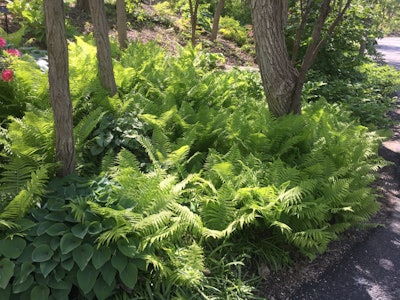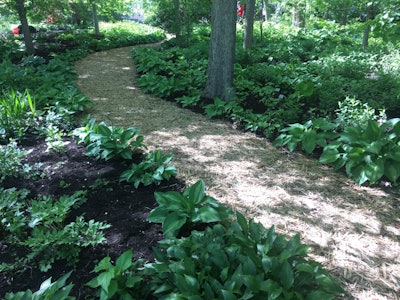
For some, this could be any green space but for others, they need a more specific type of nature to surround them: namely, a forest. The woods often holds a magical, mysterious quality to them and there are surprises to be found around each bend.
Forests offer shelter and shade that can allow a person to finally relax. In Japan, this concept is taken quite literally with the practice known as “forest bathing.” The goal is to increase mindfulness and reduce stress by getting rid of distractions and immersing oneself in nature.
According to Monrovia, the demand for woodland gardens, particularly in urban spaces, is expected to increase. Below are some of the basic principles for creating a woodland garden for clients.
Working with shade
You may think that creating a woodland garden in an urban area with no trees is out of the question, but it is actually achievable as long as there is some shade to work with. Whether it’s coming from nearby buildings or an actual tree canopy, it doesn’t really matter.
While you won’t have the ability to grow mighty oaks in a metropolitan area, you can select smaller, understory trees like crabapples or dogwoods to add vertical height to the space.
Naturally, a woodland garden is a great design option if your client already has a shady property. Rather than seeing this as a challenge, embrace the opportunity to create something sunny landscapes don’t have the ability to provide.
You do want to make sure the canopy doesn’t get too dense, so you may need to prune existing trees’ low-hanging branches to let in more light and allow your client to walk through the space without needing to duck.
Creating layers
A woodland garden may not be structured like a formal English garden, but there is still a method to the madness. The key to creating an authentic woodland garden is to ensure there are distinct layers.
Depending on who you talk to, there are different numbers of layers when it comes to creating a woodland garden, but the basic levels can be broken down to three sections. The first and most obvious layer is the canopy, which creates the shade needed for the other plants to thrive and to create a sense of shelter.
A mixture of evergreen and deciduous trees is ideal to add complexity and diversity to the woodland design. Larches, birches or poplars are all options that won’t block out too much light. It can be tempting to try to fit in too many trees since you are going for a forest feel, but the last thing you need is overcrowding and nutrient-deficient trees.
 Ferns and hostas do well in woodland gardens.
Ferns and hostas do well in woodland gardens.Photo: Jill Odom/Total Landscape Care
The next layer is the intermediate shrub layer. This could include smaller, understory trees if space allows it, but shrubs can provide a multitude of interesting textures, colors, and flowers. Azaleas, hydrangeas, mountain laurel, and rhododendrons are all solid options for shady spaces.
Woodland gardens also provide the opportunity to utilize native plants that thrive in the type of space for your region.
The third level is the ground layer, which can include smaller herbaceous plants, grasses, and ferns. You want this layer to fill in the spaces between the shrubs so unwanted plants like poison ivy cannot find a foothold. Some of the plant options for this level include coral bells, anemones, columbine, and bleeding heart.
Ferns can be your bread and butter when it comes to creating a ground layer for a woodland garden thanks to their versatility and love of shade. They can soften borders, provide eye-catching textures, and even break up color monotony. Autumn ferns in particular start out a copper-red color as they emerge.
Embracing curves
 Curving paths can help clients meander through the space slowly.
Curving paths can help clients meander through the space slowly.Photo: Jill Odom/Total Landscape Care
As for the placement of the plantings, it can be easy to create a design with patterns or lines, but this goes against the naturalistic setting of a woodland garden. Since there are rarely straight lines in nature, opt for gentle curves.
Mix plantings in a way where it appears like they would have grown that way on their own. Take a look at how natural wooded areas grow if you aren’t sure where to start. Avoid symmetry and keeping things too neat.
Another curving element to consider adding is a winding path. By creating a walkway where the destination is not already visible, it can allure the homeowner to take a stroll in the shade. Also, a twisting path slows the traveler by not providing the most direct route through the space. This can help foster the mindfulness some clients might be seeking.
Add seating
Speaking of the destination, having a place for your customer to rest in their woodland garden can help them appreciate the space more.
By taking advantage of the principles of refuge, you can reduce stress, boredom, fatigue, and vulnerability while increasing comfort.
Refuge allows the individual a view out of the space, but they are secluded with protection generally overhead and behind them. Perhaps in your seating area, you have an area cleared out where they can view another part of the space that they enjoy viewing.
Make sure the seating is something that invites them to linger and enjoy all the sights, sounds, and smells a woodland garden has to offer.










